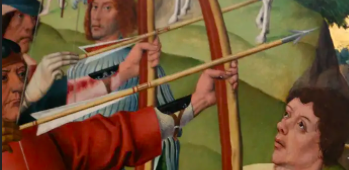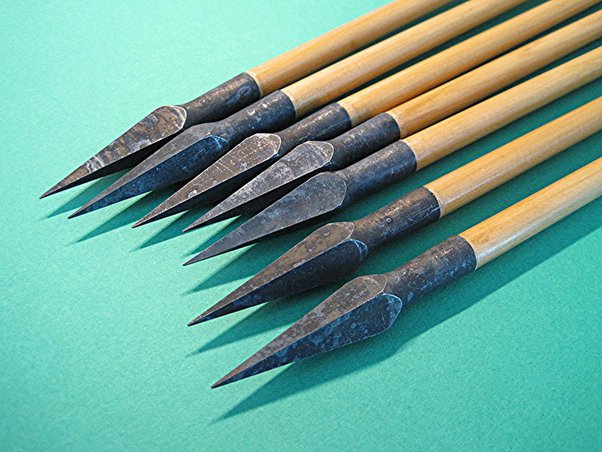If you’ve ever seen old medieval illustrations of ‘ye olde knights’ defending a castle, or lining up to face an oncoming threat from an approaching army, you’ve probably noticed that not all the depictions of arrows are the same. But what did medieval arrows really look like?
Some are long and thin, while others seem almost commonly thick and cartoonish. So what did medieval arrows really look like?
The Mary Rose, King Henry VIII’s flagship, yielded the finest extant specimens of medieval arrows ever discovered. They measured 31″ in length with the longest measured at 32.5″. At the shoulder, the arrows measured half an inch in diameter with the shafts tapering towards the nock, to a diameter of 3/8 of an inch. Impressions of glue on the shafts suggested fletchings of between 5 and 10 inches in length.
In this article, we will comprehensively explore every aspect of the design of a Longbow arrow, shedding light on the purpose and reasoning behind its specific construction.
What Did Medieval Longbow Arrows Really Look Like?

An incredible amount of craft went into making an arrow in medieval times. From the forging of the head to the shaping and weighting of the shaft, to finally fletching the final product.
Unfortunately, there are not that many arrows from the period that have survived the ravages of time. The arrows recovered from Henry VIII’s flagship, The Mary Rose, provide us with tangible examples of this archery equipment.
Archers utilized poplar and ash to construct these war arrows. However, due to their mass production, it is likely that any available wood would have sufficed. Additional woods such as birch, elder, oak, and beech were also recorded as being used.
Notably, the arrows recovered from the Mary Rose weighed between 35-60 grams, making them suitable for bows with draw weights ranging from 70-140lbs.
The Mary Rose arrows also only had the shafts and the remains of the fletching glue. The arrowheads had broken down due to saltwater exposure over hundreds of years.
On some of the arrows, you can make out that the line of attachments for the fletchings was around 6 inches. Each arrow had 3 fletches attached with a slight parabolic design.
If you’re interested in how a medieval arrow is made, make sure to check out this article.
How Thick Was A Medieval Arrow?
Modern arrows tend to be the same thickness along their entire length, but historically, that wasn’t always the case.
Medieval arrows were tapered or barrelled. What this meant was that they would have varying thicknesses from one end to the other.
Some arrows would have a thicker region around the front third of the shaft, meaning that the arrow tapered in the direction of the nock. While other shafts had the thickest area right up behind the point of the arrow.
The purpose behind this was to actively control the balance and behaviour of the arrow during its flight, according to the archer’s desired specifications.
If you wanted flight arrows for distance, then the thickest part of the arrow shaft would be at the nock end to shift the centre of gravity further back in order to give the arrow more lift.

English Longbow arrows had their centre of gravity positioned just behind the tip at the shoulder, sometimes with a thickness of up to half an inch. These arrows featured heavy iron heads, emphasizing maximum impact over long-range shooting. This arrow design, often referred to as ‘chested’ or ‘breasted’ arrows, exemplifies their unique characteristics.
When the arrow impacts the target at an angle, its energy deflects off and a lighter, thinner shaft becomes susceptible to snapping.
Related: How Fast Does a Longbow Arrow Fly?
What Were The Fletchings Made Of?
Craftsmen commonly fashioned Medieval Longbow arrow fletchings using either Goose feathers or Swan feathers. Target arrows also occasionally incorporated Peacock feathers. Notably, prior to the battle of Agincourt in 1415, Henry V famously commanded the delivery of 6 Goose feathers from every Goose in England to the Tower of London.
How Were Fletchings Attached To A Medieval Arrow?
Fletchers up and down the country would be furiously cutting and aligning the feathers onto the ends of arrows with an angle of 120-degree space between fletches.
Archers would attach the fletches to the shaft by combining beeswax, copper verdigris, and kidney fat resin to create glue. To ensure a secure bond, they employed silk thread or linen binding since the glue lacked waterproof properties.
Five turns per inch were generally the standard measure.
Why Were Medieval Arrow Fletchings So Long?
Upon release from the bow, arrows experience a period of fishtailing. This is characterized by lateral movement from side to side, before eventually stabilizing and successfully reaching their intended targets.
Longer fletchings will help to straighten and stabilize the arrow much faster out of the bow creating an optimal flight path to the target.
This is beneficial to the archer who is shooting a target at a shorter range because the arrow is much more likely to hit the target straight on, rather than bouncing off due to fishtailing.
What Were Medieval Arrowheads Made From?
Craftsmen forged them from iron or steel. There were many different designs of arrowheads in the Middle Ages, however, the most commonly found arrowhead is the bodkin.

Archers actively employed the long, thin bodkin head to penetrate mail armour with precision, while they turned to a shorter version for effectively targeting plate armour.
As armour in the Middle Ages became more proficient at stopping arrows, arrowsmiths had to become more inventive at producing arrowheads with a greater potential for penetration.
Related: How Medieval Longbow arrows are made.
Conclusion
A medieval Longbow arrow was a weighty, valuable thing at the time. Movies often mislead viewers by portraying the indiscriminate shooting of arrows in large quantities. This led to a misconception of significant waste. In reality, archers dedicated considerable time and practice to ensure the utmost precision and impact with each arrow they released.
Archers exerted significant effort to make sure that every arrow had the desired impact. Both when launching them as the first line of defence over long distances or aiming for maximum penetration at shorter ranges.

0 Comments